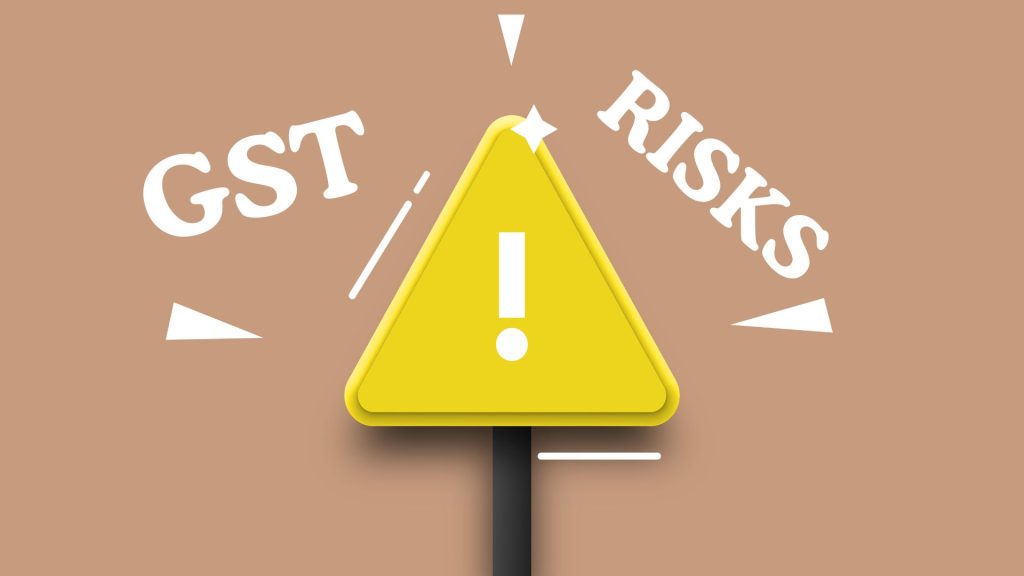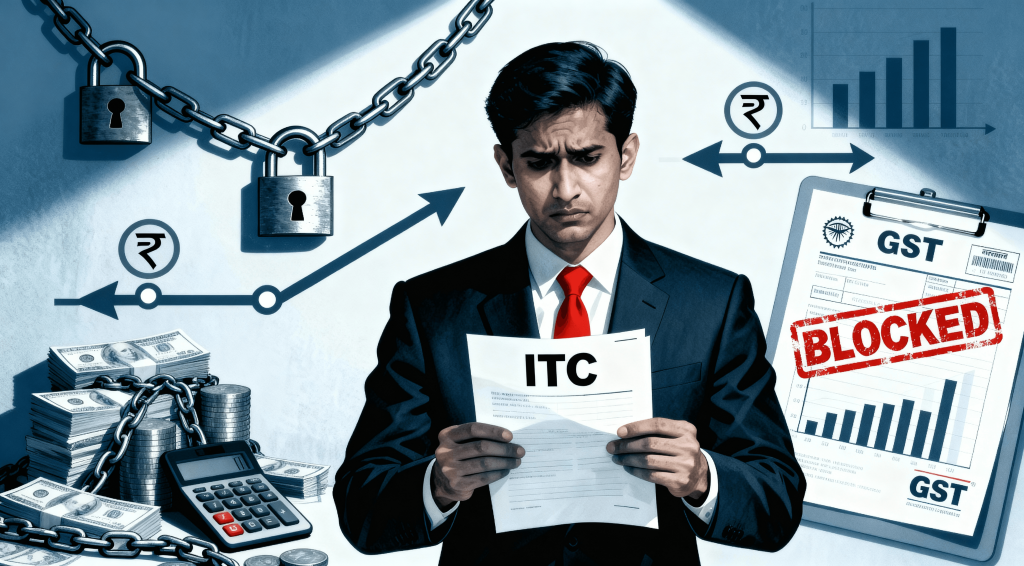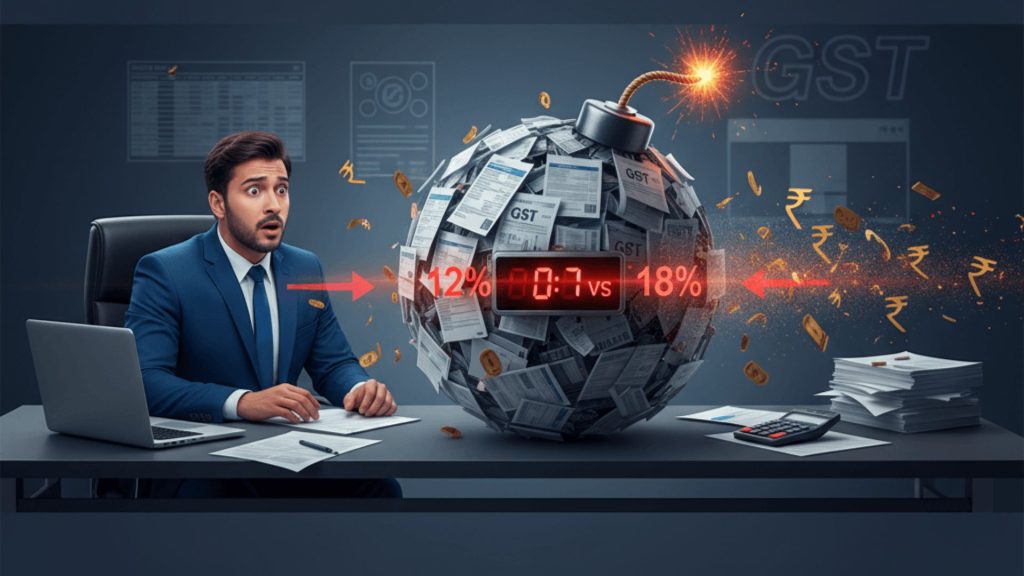
Most business owners think GST is just about filing returns and claiming credits. But the truth is — GST is one of the biggest profit-sensitive areas in modern businesses.
At Vizttax, we’ve seen financially sound companies lose significant value — not due to fraud or non-compliance, but because of systemic GST mistakes that quietly reduce profitability, create cash flow strain, and expose them to unnecessary tax scrutiny.
If GST is not handled strategically, it doesn’t just create penalties — it creates losses you never see coming.
Let’s explore the Four biggest GST risks that can silently drain your profits and the practical ways to eliminate them.
1. Blocked Input Tax Credit (ITC): The Hidden Cash Flow Killer

Even though you’ve paid the tax to your vendor, you end up paying it again to the government.
This means your working capital gets locked unnecessarily — a direct hit to liquidity.
Example:
A manufacturing unit purchasing raw materials worth ₹1 crore at 18% GST loses ₹18 lakh in ITC if the supplier fails to file GSTR-1. That ₹18 lakh immediately turns into a cash blockage, reducing funds available for operations.
How to Prevent This Risk:
- Link vendor payments with GSTR-1 filing: Release GST payment to vendors only after their invoices are reflected in your GSTR-2B. This ensures that the tax has been properly reported by the supplier and your ITC remains valid.
- Conduct monthly IMS and GSTR-2B vs. purchase book reconciliations: Identify missing, mismatched, or duplicate entries before filing GSTR-3B to avoid disputes and cash blockages.
- Perform vendor GST health checks before onboarding: Prefer suppliers with a consistent GST filing history and active GSTIN status to minimize future ITC denials.
- Automate ITC tracking and vendor follow-up: Use a dashboard or ERP add-on that highlights blocked, pending, or ineligible ITC in real time and generates automatic alerts for non-compliant vendors.
- Monitor reverse charge and re-eligibility credits: Many businesses lose ITC due to missed self-invoice entries or untracked re-eligibility under reverse charge — set up internal control sheets for these cases.

A strong ITC control mechanism is not just a tax safeguard — it’s a cash flow optimization tool.
2. Wrong Classification or Tax Rate: The Silent Time Bomb

GST classification errors are far more common than most realize.
Businesses often apply rates based on assumptions, old service tax rules, or peer practices. But a small mismatch — say charging 12% instead of 18% — can attract retrospective tax demands, penalties, and interest running into lakhs.
Example:
A tech company categorized its software maintenance service under 12% instead of 18%. During departmental audit, the demand for three years, with interest and penalty, came close to ₹42 lakh — all due to incorrect classification.
How to Prevent This Risk:
-
Review your HSN & SAC codes annually: Products, services, and their specifications evolve — but GST classifications often remain untouched for years.
Conduct an annual HSN/SAC review to ensure your current offerings are still mapped to the correct headings and rates. Any new product, bundled offer, or service variant should be reviewed before invoicing begins. - Avoid guesswork in mixed or composite supplies: When two or more goods/services are supplied together (like hardware + installation or content + training), the classification can change entirely. Seek a professional opinion or advance ruling instead of relying on assumptions or vendor practices. A proactive clarification can save lakhs in penalties later.
-
Maintain a Classification Register:
Create and update a detailed internal register listing:
- Each product/service name
- Applicable HSN/SAC code and GST rate
- Relevant notifications, circulars, or rulings relied upon
- Date of last review and person responsible
This acts as strong evidence of diligence during audits and supports your case in disputes.
-
Align contracts, purchase orders, and invoices:
A frequent cause of litigation is mismatch between agreement language and invoice description.
Ensure your contracts clearly describe the nature of supply in the same terms as used in invoices and tax documents. Ambiguous wording often gives room for tax officers to question classification or rate.

The right classification today can prevent years of future litigation.
3. Weak Documentation and Compliance Gaps: The Litigation Magnet

GST compliance is document-driven.
Even genuine transactions can be disallowed if supporting records are missing, incomplete, or inconsistent.
We often see businesses lose disputes simply because they could not present proper proof, not because they were wrong.
In GST, the golden rule is simple — “No proof, no claim.”
Common Weak Points:
- Missing e-way bills or mismatched vehicle details.
- Invoices without clear service description.
- No vendor confirmation or payment proof.
- Unrecorded amendments or delayed reconciliations.
How to Prevent This Risk:
-
Maintain a digital GST file for every financial year:
Build a structured folder for each year containing:
- Tax invoices (sales and purchase)
- E-way bills and delivery challans
- Input tax credit reconciliation statements (GSTR-2B vs. books)
- Departmental notices, replies, and submissions
Keeping everything year-wise ensures that no record is lost during audit or litigation.
-
Adopt cloud-based document storage integrated with your accounting system:
Manual storage and local drives are prone to data loss. Use secure, cloud-based software that automatically links each invoice with corresponding GST data for easy retrieval during assessments or appeals. -
Respond to every departmental notice formally and with documentation:
Avoid verbal communication or informal replies. Every response should be drafted, dated, and supported with evidence — such as invoices, ledgers, or reconciliations — and acknowledged through proper channels (DSC or GST portal submission).
This creates a strong audit trail that protects you during appellate proceedings. -
Conduct an annual GST health audit:
Before the department does, identify your own weak spots.
A GST documentation audit reviews your invoices, returns, reconciliations, and communication records to ensure that every transaction can be substantiated on demand. -
Train your team on document discipline:
Many compliance errors stem from untrained staff.
Conduct internal workshops or refresher sessions to ensure that the team understands what documents to collect, retain, and how to respond professionally to GST officers.

In GST, documentation is your first line of defence — and your last line of protection.
4. Neglecting Internal GST Controls: The Invisible Exposure

Another major risk lies in internal control failure.
When multiple departments — accounts, logistics, purchase, and sales — handle GST independently, mismatches and errors multiply.
Best Practices for Control:
- Integrate GST workflows into your accounting system, not as an afterthought.
- Implement maker-checker review for returns and reconciliations.
- Ensure that accounting and GST teams communicate, especially for debit/credit notes and stock transfers.

Strong internal control isn’t about extra work — it’s about preventing costly surprises.
Final Insight: Treat GST as a Profit Centre, Not a Compliance Burden
GST is not merely a statutory requirement — it’s a strategic financial function.
A proactive GST framework helps businesses:
- Improve cash flow
- Avoid unnecessary litigation
- Build confidence with investors and lenders
- Strengthen long-term financial governance
At Vizttax, we help businesses transform GST from a compliance obligation into a profit protection system.
Our approach focuses on preventive strategies, documentation discipline, and practical implementation support — so that your GST never becomes a financial burden.
Because in taxation, the most expensive mistakes are the ones you never notice.
Need Professional Insight?
If you’d like to assess whether your GST systems are truly efficient, you can schedule a professional review or discussion with our team at Vizttax.
We’ll help you identify key risks, strengthen documentation, and bring clarity to your GST processes — all within the boundaries of professional ethics and confidentiality.

Good one
Thank you Mr. Baskaran for your appreciation.